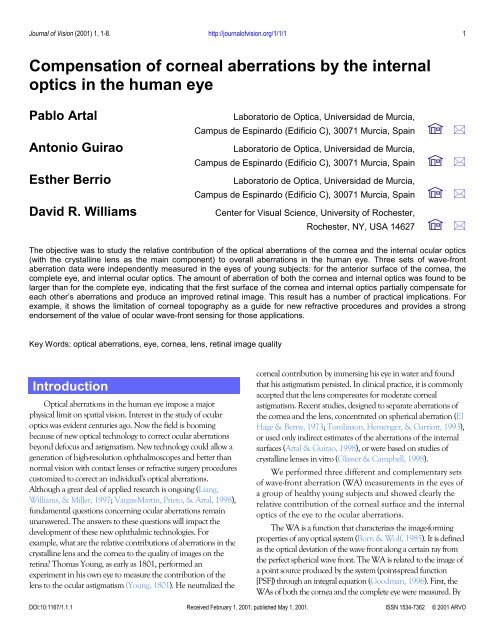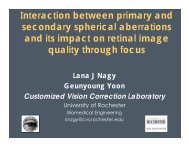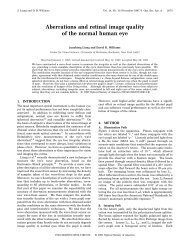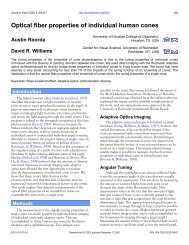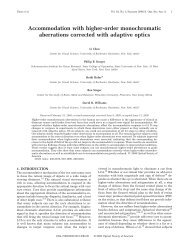Compensation of corneal aberrations by the ... - Journal of Vision
Compensation of corneal aberrations by the ... - Journal of Vision
Compensation of corneal aberrations by the ... - Journal of Vision
Create successful ePaper yourself
Turn your PDF publications into a flip-book with our unique Google optimized e-Paper software.
<strong>Journal</strong> <strong>of</strong> <strong>Vision</strong> (2001) 1, 1-8. http://journal<strong>of</strong>vision.org/1/1/1 1<strong>Compensation</strong> <strong>of</strong> <strong>corneal</strong> <strong>aberrations</strong> <strong>by</strong> <strong>the</strong> internaloptics in <strong>the</strong> human eyePablo ArtalAntonio GuiraoEs<strong>the</strong>r BerrioDavid R. WilliamsLaboratorio de Optica, Universidad de Murcia,Campus de Espinardo (Edificio C), 30071 Murcia, SpainLaboratorio de Optica, Universidad de Murcia,Campus de Espinardo (Edificio C), 30071 Murcia, SpainLaboratorio de Optica, Universidad de Murcia,Campus de Espinardo (Edificio C), 30071 Murcia, SpainCenter for Visual Science, University <strong>of</strong> Rochester,Rochester, NY, USA 14627The objective was to study <strong>the</strong> relative contribution <strong>of</strong> <strong>the</strong> optical <strong>aberrations</strong> <strong>of</strong> <strong>the</strong> cornea and <strong>the</strong> internal ocular optics(with <strong>the</strong> crystalline lens as <strong>the</strong> main component) to overall <strong>aberrations</strong> in <strong>the</strong> human eye. Three sets <strong>of</strong> wave-frontaberration data were independently measured in <strong>the</strong> eyes <strong>of</strong> young subjects: for <strong>the</strong> anterior surface <strong>of</strong> <strong>the</strong> cornea, <strong>the</strong>complete eye, and internal ocular optics. The amount <strong>of</strong> aberration <strong>of</strong> both <strong>the</strong> cornea and internal optics was found to belarger than for <strong>the</strong> complete eye, indicating that <strong>the</strong> first surface <strong>of</strong> <strong>the</strong> cornea and internal optics partially compensate foreach o<strong>the</strong>r’s <strong>aberrations</strong> and produce an improved retinal image. This result has a number <strong>of</strong> practical implications. Forexample, it shows <strong>the</strong> limitation <strong>of</strong> <strong>corneal</strong> topography as a guide for new refractive procedures and provides a strongendorsement <strong>of</strong> <strong>the</strong> value <strong>of</strong> ocular wave-front sensing for those applications.Key Words: optical <strong>aberrations</strong>, eye, cornea, lens, retinal image qualityIntroductionOptical <strong>aberrations</strong> in <strong>the</strong> human eye impose a majorphysical limit on spatial vision. Interest in <strong>the</strong> study <strong>of</strong> ocularoptics was evident centuries ago. Now <strong>the</strong> field is boomingbecause <strong>of</strong> new optical technology to correct ocular <strong>aberrations</strong>beyond defocus and astigmatism. New technology could allow ageneration <strong>of</strong> high-resolution ophthalmoscopes and better thannormal vision with contact lenses or refractive surgery procedurescustomized to correct an individual's optical <strong>aberrations</strong>.Although a great deal <strong>of</strong> applied research is ongoing (Liang,Williams, & Miller, 1997; Vargas-Martín, Prieto, & Artal, 1998),fundamental questions concerning ocular <strong>aberrations</strong> remainunanswered. The answers to <strong>the</strong>se questions will impact <strong>the</strong>development <strong>of</strong> <strong>the</strong>se new ophthalmic technologies. Forexample, what are <strong>the</strong> relative contributions <strong>of</strong> <strong>aberrations</strong> in <strong>the</strong>crystalline lens and <strong>the</strong> cornea to <strong>the</strong> quality <strong>of</strong> images on <strong>the</strong>retina? Thomas Young, as early as 1801, performed anexperiment in his own eye to measure <strong>the</strong> contribution <strong>of</strong> <strong>the</strong>lens to <strong>the</strong> ocular astigmatism (Young, 1801). He neutralized <strong>the</strong><strong>corneal</strong> contribution <strong>by</strong> immersing his eye in water and foundthat his astigmatism persisted. In clinical practice, it is commonlyaccepted that <strong>the</strong> lens compensates for moderate <strong>corneal</strong>astigmatism. Recent studies, designed to separate <strong>aberrations</strong> <strong>of</strong><strong>the</strong> cornea and <strong>the</strong> lens, concentrated on spherical aberration (ElHage & Berny, 1973; Tomlinson, Hemenger, & Garriott, 1993),or used only indirect estimates <strong>of</strong> <strong>the</strong> <strong>aberrations</strong> <strong>of</strong> <strong>the</strong> internalsurfaces (Artal & Guirao, 1998), or were based on studies <strong>of</strong>crystalline lenses in vitro (Glasser & Campbell, 1998).We performed three different and complementary sets<strong>of</strong> wave-front aberration (WA) measurements in <strong>the</strong> eyes <strong>of</strong>a group <strong>of</strong> healthy young subjects and showed clearly <strong>the</strong>relative contribution <strong>of</strong> <strong>the</strong> <strong>corneal</strong> surface and <strong>the</strong> internaloptics <strong>of</strong> <strong>the</strong> eye to <strong>the</strong> ocular <strong>aberrations</strong>.The WA is a function that characterizes <strong>the</strong> image-formingproperties <strong>of</strong> any optical system (Born & Wolf, 1985). It is definedas <strong>the</strong> optical deviation <strong>of</strong> <strong>the</strong> wave front along a certain ray from<strong>the</strong> perfect spherical wave front. The WA is related to <strong>the</strong> image <strong>of</strong>a point source produced <strong>by</strong> <strong>the</strong> system (point-spread function[PSF]) through an integral equation (Goodman, 1996). First, <strong>the</strong>WAs <strong>of</strong> both <strong>the</strong> cornea and <strong>the</strong> complete eye were measured. ByDOI:10:1167/1.1.1 Received February 1, 2001; published May 1, 2001. ISSN 1534-7362 © 2001 ARVO
Artal, Guirao, Berrio & Williams 2combining <strong>the</strong>se two sets <strong>of</strong> data, <strong>the</strong> <strong>aberrations</strong> <strong>of</strong> <strong>the</strong> internaloptics were estimated <strong>by</strong> direct subtraction. Then <strong>the</strong> WA <strong>of</strong> <strong>the</strong>eye was measured after neutralizing <strong>the</strong> cornea using swimminggoggles filled with saline water. The <strong>aberrations</strong> measured with <strong>the</strong>filled goggles correspond approximately to those <strong>of</strong> <strong>the</strong> internalocular optics. The crystalline lens is <strong>the</strong> most important contributorto <strong>the</strong> <strong>aberrations</strong> <strong>of</strong> <strong>the</strong> internal ocular optics that also includes<strong>the</strong> posterior surface <strong>of</strong> <strong>the</strong> cornea and <strong>the</strong> ocular media.MethodsFigure 1 shows a schematic diagram <strong>of</strong> <strong>the</strong> experimentalprocedure. From <strong>the</strong> <strong>aberrations</strong> <strong>of</strong> <strong>the</strong> complete eye and<strong>the</strong> cornea, those <strong>of</strong> <strong>the</strong> internal optics are estimated <strong>by</strong>direct subtraction. The <strong>aberrations</strong> <strong>of</strong> <strong>the</strong> internal opticsare directly measured after neutralizing <strong>the</strong> <strong>aberrations</strong> <strong>of</strong><strong>the</strong> first <strong>corneal</strong> surface.internal optics = eye - cornea+ =internal optics (directly)optics to <strong>the</strong> overall ocular aberration were evaluated. Thegeometric center <strong>of</strong> <strong>the</strong> pupil was used as <strong>the</strong> reference pointfor <strong>the</strong> registration between H-S and <strong>corneal</strong> measurements.In a simple model with <strong>the</strong> two series <strong>of</strong> Zernike coefficientsfor <strong>the</strong> cornea and <strong>the</strong> eye, <strong>the</strong> <strong>aberrations</strong> <strong>of</strong> <strong>the</strong> internaloptics were obtained <strong>by</strong> direct subtraction <strong>of</strong> each pair <strong>of</strong>coefficients. It was assumed that <strong>the</strong> wave <strong>aberrations</strong> were<strong>the</strong> same axially along small distances.In addition, <strong>the</strong> WA for <strong>the</strong> internal optics was directlymeasured with <strong>the</strong> H-S sensor when refraction and<strong>aberrations</strong> <strong>of</strong> <strong>the</strong> <strong>corneal</strong> surface were cancelled <strong>by</strong>immersing <strong>the</strong> eye in saline water using swimming goggles(Millodot & Sivak, 1979). Light reached <strong>the</strong> eye through ahole along <strong>the</strong> optical axis <strong>of</strong> <strong>the</strong> goggles that was covered <strong>by</strong>a high-quality optical window. When <strong>the</strong> <strong>corneal</strong> surfacepower is cancelled, <strong>the</strong> eye becomes highly hyperopic. Toobtain H-S images adequate for processing, this large defocuswas compensated with a Badal optometer formed <strong>by</strong> twophotographic objectives (Figure 2B). By using thisprocedure, several problems may affect <strong>the</strong> estimates <strong>of</strong> <strong>the</strong><strong>aberrations</strong> <strong>of</strong> <strong>the</strong> internal optics. When <strong>the</strong> H-S sensor isused at <strong>the</strong> extreme vergence required for correcting <strong>the</strong> eye’shyperopia, <strong>the</strong> apparatus itself introduces large <strong>aberrations</strong>that may affect <strong>the</strong> results. This issue was overcome <strong>by</strong> usinga reference image <strong>of</strong> <strong>the</strong> system, recorded in <strong>the</strong> sameconditions, to compute <strong>the</strong> <strong>aberrations</strong> <strong>of</strong> <strong>the</strong> internal ocularoptics. This removes any systematic <strong>aberrations</strong> present in<strong>the</strong> apparatus. In addition, <strong>the</strong> optical window placed infront <strong>of</strong> <strong>the</strong> goggles and <strong>the</strong> water act as a plane parallel platethat introduces spherical aberration for those vergences. Thespherical aberration was calculated with a ray-tracingprogram and incorporated into <strong>the</strong> data analysis.+ =(b)hyperopiacorrection(46 D)salinewaterFigure 1. Schematic diagram <strong>of</strong> <strong>the</strong> experiments performed.The WA <strong>of</strong> <strong>the</strong> eye was measured with a Hartmann-Shack (H-S) sensor (Liang, Grimm, Goelz, & Bille, 1994; Liang& Williams, 1997; Prieto, Vargas-Martín, Goelz, & Artal, 2000).A narrow infrared beam that acts as a beacon source isproduced <strong>by</strong> a super-luminescent diode and is projectedinto <strong>the</strong> subject's retina. In <strong>the</strong> second pass, a microlensarray, conjugated with <strong>the</strong> eye pupil, produces an image <strong>of</strong>spots on a charged-coupled device camera (CCD) (Figure2A). The relative displacements <strong>of</strong> <strong>the</strong> spots areproportional to <strong>the</strong> WA local slopes. Then <strong>the</strong> WA isreconstructed as a Zernike polynomial expansion (Noll,1976). The <strong>aberrations</strong> introduced <strong>by</strong> <strong>the</strong> anterior surface<strong>of</strong> <strong>the</strong> cornea were calculated from <strong>the</strong> <strong>corneal</strong> shape,measured <strong>by</strong> a videokeratographic device (MasterVue<strong>corneal</strong> topography system; Humphrey Instruments, SanLeandro, CA). Once <strong>the</strong> anterior <strong>corneal</strong> surface wasmodeled, <strong>the</strong> difference in optical path between <strong>the</strong> chiefray and a marginal ray over <strong>the</strong> pupil yields <strong>the</strong> WA for <strong>the</strong>cornea (Guirao & Artal, 2000). From <strong>the</strong>se two WA maps,<strong>the</strong> relative contributions <strong>of</strong> <strong>the</strong> cornea and <strong>the</strong> internalfocuscorrectormicrolensarrayCCD(a)SLDobjective(50 mm)objective(50 mm)gogglesFigure 2. A. Schematic diagram <strong>of</strong> <strong>the</strong> Hartmann-Shack wavefrontsensor used to measure <strong>the</strong> <strong>aberrations</strong> <strong>of</strong> <strong>the</strong> completeeye. SLD indicates super-luminescent source; CCD, chargedcoupleddevice camera. B. Diagram <strong>of</strong> <strong>the</strong> part <strong>of</strong> <strong>the</strong> set-upmodified to measure <strong>the</strong> aberration <strong>of</strong> <strong>the</strong> internal optics. Theeye was equipped with swimming goggles filled with salinewater. Defocus was compensated <strong>by</strong> <strong>the</strong> relative position <strong>of</strong> <strong>the</strong>two 50-mm objectives.
Artal, Guirao, Berrio & Williams 3Figure 3 shows 2 examples <strong>of</strong> H-S images recorded in<strong>the</strong> naked eye (A) and in <strong>the</strong> eye with filled goggles (B).From independent measurements, we have <strong>the</strong> estimates <strong>of</strong>wave-front <strong>aberrations</strong> for <strong>the</strong> different optical components(anterior surface <strong>of</strong> <strong>the</strong> cornea and internal optics);<strong>the</strong>refore, <strong>the</strong> comparison <strong>of</strong> <strong>the</strong>se estimates indicates <strong>the</strong>validity <strong>of</strong> <strong>the</strong> methods.(a b)Figure 3. Examples <strong>of</strong> Hartmann-Shack image in <strong>the</strong> naked eye(A) and in <strong>the</strong> eye with filled goggles (B).Aberrations <strong>of</strong> <strong>the</strong> cornea, measured both directly from<strong>the</strong> shape and <strong>by</strong> subtraction <strong>of</strong> <strong>the</strong> <strong>aberrations</strong> obtainedwith goggles from those <strong>of</strong> <strong>the</strong> whole, were found to besimilar within <strong>the</strong> experimental variability. Figure 4 fur<strong>the</strong>rexplains this comparison. Figure 5 shows <strong>the</strong> Zernikecoefficients <strong>of</strong> <strong>the</strong> <strong>aberrations</strong> for <strong>the</strong> anterior <strong>corneal</strong>surface obtained both directly (videokeratography) andindirectly (goggles) for 2 subjects. This result providesstrong evidence for consistency <strong>of</strong> <strong>the</strong> complete procedure,supporting <strong>the</strong> simple model where <strong>corneal</strong> and internaloptics <strong>aberrations</strong> are added in a single plane to produce<strong>the</strong> overall ocular <strong>aberrations</strong>.from <strong>corneal</strong>opographyWA(complete eye)-fromWA(internal)gogglesdirectindirectWA(cornea)Figure 4. Schematic procedure to estimate <strong>the</strong> <strong>aberrations</strong> <strong>of</strong> <strong>the</strong>cornea directly and from indirect measurements (complete eyeand anterior <strong>corneal</strong> surface).We carried out <strong>the</strong> indirect set <strong>of</strong> measurements (withand without filled goggles) on <strong>the</strong> eyes <strong>of</strong> 5 subjects and <strong>the</strong>measurement <strong>of</strong> <strong>corneal</strong> and complete eye <strong>aberrations</strong> inano<strong>the</strong>r group <strong>of</strong> 6 subjects. In 2 <strong>of</strong> <strong>the</strong> subjects for whichgoggle measurements were performed, <strong>corneal</strong> topographyfor comparison (Figure 5) was also available. All <strong>of</strong> <strong>the</strong>subjects analyzed had normal vision (corrected visual acuity1 [20/20] or better). Their ages ranged from 24 to 38 years.The study followed <strong>the</strong> tenets <strong>of</strong> <strong>the</strong> Declaration <strong>of</strong>Helsinki, and signed informed consent was obtained fromevery subject after <strong>the</strong> nature and all possible consequences<strong>of</strong> <strong>the</strong> study had been explained. The H-S images wererecorded with paralyzed accommodation (usingcyclopentholate 1%) and infrared light (780 nm). The<strong>aberrations</strong> were estimated for different pupil diameters(4.7 mm when <strong>aberrations</strong> <strong>of</strong> <strong>the</strong> internal optics wereobtained directly from <strong>the</strong> goggle experiment and 5.9 in <strong>the</strong>remainder <strong>of</strong> <strong>the</strong> cases).micronsmicrons0.40.20.0-0.2-0.40.40.20.0-0.2-0.4C -2 2C 2 2C -1 3C 1 3 C 3 3(a)(b)C 2 4 C 4 4C -3 3 C 0 4 C -2 4Zernike termsFigure 5. Zernike coefficients <strong>of</strong> <strong>the</strong> <strong>aberrations</strong> <strong>of</strong> <strong>the</strong> cornea for2 subjects, obtained from <strong>the</strong> shape (circles) and <strong>by</strong> subtraction<strong>of</strong> <strong>the</strong> <strong>aberrations</strong> <strong>of</strong> <strong>the</strong> whole eye and <strong>the</strong> internal surfaces(triangles), as described in Figure 4.C -4 4
Artal, Guirao, Berrio & Williams 4ResultsThe results presented in this section are direct measurements<strong>of</strong> <strong>the</strong> <strong>aberrations</strong> <strong>of</strong> <strong>the</strong> anterior <strong>corneal</strong> surface and <strong>the</strong> completeeye, and indirect estimates <strong>of</strong> <strong>the</strong> <strong>aberrations</strong> <strong>of</strong> <strong>the</strong> internalsurfaces. Figure 6 shows a representative example <strong>of</strong> <strong>the</strong> results for1 <strong>of</strong> <strong>the</strong> subjects: <strong>the</strong> WA maps for <strong>the</strong> cornea (A), <strong>the</strong> internaloptics (B), and <strong>the</strong> complete eye (C) toge<strong>the</strong>r with <strong>the</strong>ir associatedPSFs calculated at <strong>the</strong> best image plane (D-F). In this subject, <strong>the</strong>magnitude <strong>of</strong> <strong>aberrations</strong> is larger in <strong>the</strong> cornea than in <strong>the</strong>complete eye. This can be easily noted in <strong>the</strong> wrappedrepresentation <strong>of</strong> <strong>the</strong> WAs <strong>by</strong> counting <strong>the</strong> number <strong>of</strong>phase-steps appearing in <strong>the</strong> maps for <strong>the</strong> cornea and for<strong>the</strong> complete eye, or, alternatively, <strong>by</strong> comparing <strong>the</strong>spreads <strong>of</strong> <strong>the</strong> associated PSFs.Figure 7 shows <strong>the</strong> Zernike terms for <strong>the</strong> <strong>aberrations</strong> <strong>of</strong><strong>the</strong> cornea (solid symbols) and <strong>the</strong> internal optics for allsubjects. The magnitude <strong>of</strong> <strong>the</strong> most important aberrationterms is similar for <strong>the</strong> two components, but with a changein sign. This produces an eye with smaller amounts <strong>of</strong><strong>aberrations</strong> than its main components, indicating that <strong>the</strong>internal optics partially compensate for <strong>the</strong> <strong>aberrations</strong> <strong>of</strong><strong>the</strong> anterior surface <strong>of</strong> <strong>the</strong> cornea. Figure 8 shows <strong>the</strong> rootmean square <strong>of</strong> <strong>the</strong> WA (a parameter indicating <strong>the</strong>magnitude <strong>of</strong> <strong>the</strong> aberration) for <strong>the</strong> eye, <strong>the</strong> anteriorsurface <strong>of</strong> <strong>the</strong> cornea, and <strong>the</strong> internal optics for 6 eyesafter defocus was removed. In every case, <strong>the</strong> <strong>aberrations</strong> <strong>of</strong><strong>the</strong> <strong>corneal</strong> surface and <strong>the</strong> isolated internal optics arelarger than those <strong>of</strong> <strong>the</strong> total eye.a b cd e fFigure 6. A-C. Wave-front aberration (WA) maps for <strong>the</strong> cornea(A), <strong>the</strong> internal optics (B) and <strong>the</strong> complete eye (C). These WAsare represented as modulo-π. The pupil diameter was 5.9 mm.D-E. Associated point-spread functions (PSFs) calculated at <strong>the</strong>best image plane from WA panels A-C. Each image subtends 20minutes <strong>of</strong> arc <strong>of</strong> visual field.microns0.80.40.0-0.4-0.8C -2 2 C 2 2C -1 3 C 1 3 C -3 3 C 3 3 C 0 4 C 2 4 C -2 4Zernike termsFigure 7. Zernike terms for <strong>the</strong> cornea (solid symbols) and <strong>the</strong>internal optics (open symbols) for all subjects.RMS (microns)1.41.21.00.80.60.40.20.0corneainternaleyesubjectC 4 4Figure 8. Root mean square <strong>of</strong> <strong>the</strong> wave-front aberration <strong>of</strong> <strong>the</strong>eye (squares), <strong>the</strong> cornea (circles), and <strong>the</strong> internal optics(triangles) for 6 eyes after defocus was removed.Figure 9 shows <strong>the</strong> values <strong>of</strong> <strong>the</strong> Zernike terms up t<strong>of</strong>ourth order (from 5 to 14) for all subjects for <strong>the</strong> <strong>corneal</strong>surface versus <strong>the</strong> internal optics. There is a significantnegative correlation between <strong>corneal</strong> and internal optics<strong>aberrations</strong> (regression coefficient, 0.86). This resultindicates a significant coupling <strong>of</strong> individual aberrationterms between <strong>the</strong> cornea and <strong>the</strong> internal ocular optics.Astigmatism for <strong>the</strong> cornea and internal optics (Zerniketerms 5 and 6) had opposite signs. Figure 10 shows <strong>the</strong>astigmatism <strong>of</strong> <strong>the</strong> <strong>corneal</strong> surface versus <strong>the</strong> internaloptics. This supports a well-known fact in clinical practice:<strong>the</strong> internal optics tend to compensate for <strong>the</strong> <strong>corneal</strong>astigmatism. However, what is more surprising is that thiscompensation also takes place for higher order <strong>aberrations</strong>.Third- and fourth-order <strong>aberrations</strong> were also partiallycompensated. A large fraction <strong>of</strong> <strong>the</strong> spherical aberration <strong>of</strong><strong>the</strong> cornea is cancelled <strong>by</strong> <strong>the</strong> internal optics. Themagnitude <strong>of</strong> comalike <strong>aberrations</strong> <strong>of</strong> <strong>the</strong> cornea is alsosignificantly reduced <strong>by</strong> <strong>the</strong> internal optics. Figure 11 shows
Artal, Guirao, Berrio & Williams 5<strong>the</strong> values <strong>of</strong> third-order coma and triangular astigmatismfor <strong>the</strong> cornea versus <strong>the</strong> internal surfaces. Figure 12 shows<strong>the</strong> fraction <strong>of</strong> <strong>the</strong> spherical aberration and coma in <strong>the</strong>cornea that is compensated <strong>by</strong> <strong>the</strong> internal surfaces.internal surfaces (microns)0.80.40.0-0.4-0.8-0.8 -0.4 0.0 0.4 0.8anterior cornea (microns)Figure 9. Values <strong>of</strong> Zernike terms up to fourth order (5-14) for<strong>the</strong> <strong>aberrations</strong> <strong>of</strong> <strong>the</strong> cornea versus <strong>the</strong> internal optics for allsubjects.internal surfaces (microns)0.50-0.5-1-0.5 0 0.5 1anterior cornea (microns)Figure 10. Values <strong>of</strong> astigmatism for <strong>the</strong> cornea versus <strong>the</strong>internal optics for all subjects.internal surfaces (microns)0.40.30.20.10-0.1-0.2-0.3comatriangularastigmatism-0.4-0.4 -0.3 -0.2 -0.1 0 0.1 0.2 0.3 0.4anterior cornea (microns)Figure 11. Value <strong>of</strong> third-order coma and triangular astigmatismfor <strong>the</strong> cornea versus <strong>the</strong> internal optics for all subjects.fraction compensated (%)100806040200-20-40-60subjectFigure 12. Fraction <strong>of</strong> spherical aberration (solid circles) andcoma (open circles) <strong>of</strong> <strong>the</strong> cornea that are compensated <strong>by</strong> <strong>the</strong>internal surfaces in every subject.DiscussionThis balance <strong>of</strong> <strong>corneal</strong> and internal <strong>aberrations</strong>represents a typical example <strong>of</strong> a coupling <strong>of</strong> 2 opticalsystems. In this case, <strong>the</strong> <strong>corneal</strong> surface and <strong>the</strong> internalocular optics, both with a relative poor optical quality,combine to form a system with a better opticalperformance. In optical engineering, a series <strong>of</strong> lenses incascade are usually used to optimize <strong>the</strong> overall quality <strong>of</strong><strong>the</strong> system (Smith, 1990); however, <strong>the</strong> situation in <strong>the</strong> eye isdifferent in that <strong>the</strong>re is not a simple access to every lens as
Artal, Guirao, Berrio & Williams 6a separate component. How this optical qualityoptimization occurs in <strong>the</strong> human eye is not clear. One canimagine ei<strong>the</strong>r an active process or that <strong>the</strong> compensation issimply a passive consequence <strong>of</strong> some random positioning<strong>of</strong> <strong>the</strong> ocular elements.The distributions <strong>of</strong> astigmatism and sphericalaberration reveal systematic patterns in <strong>the</strong> population <strong>of</strong>eyes (ie, opposite sign <strong>of</strong> <strong>the</strong> spherical <strong>aberrations</strong> <strong>of</strong><strong>corneal</strong> and internal optics [Zernike terms 5, 6, and 11 inFigure 7]). This may suggest an evolutionary process to reachan optimum balance for those aberration terms. However,o<strong>the</strong>r <strong>aberrations</strong>, such as coma, seem to distributerandomly from subject to subject, favoring a passivecompensation process or perhaps one in which activecompensation can occur during development.There are not enough precise data on <strong>the</strong> shape,location, and refractive index <strong>of</strong> every ocular component todetermine <strong>the</strong> physical basis for <strong>the</strong> compensation.However, a simple model provides a general picture <strong>of</strong> whatcould be happening in a normal, nearly emmetropic youngeye. The <strong>corneal</strong> surface has spherical aberration and acertain amount <strong>of</strong> astigmatism and comalike <strong>aberrations</strong>with orientation and magnitude varying from subject tosubject. Internal optics can be understood as <strong>the</strong> lens,which when isolated presents only spherical <strong>aberrations</strong>imilar in magnitude to that <strong>of</strong> <strong>the</strong> cornea but withopposite sign. An optical element with only fourth-orderspherical aberration generates lower-order terms (comalike,astigmatism, defocus, and tilts) when it is decentered (López-Gil, Howland, Howland, Charman, & Applegate, 1998) ortilted with respect to <strong>the</strong> axis. Small decentering and tilts <strong>of</strong><strong>the</strong> lens produce <strong>aberrations</strong> with a similar magnitude for<strong>the</strong> internal optics that we measured. This simple modelmay explain how <strong>the</strong> compensation is achieved: <strong>the</strong> lensmoves and tilts slightly to compensate in part for <strong>the</strong><strong>aberrations</strong> <strong>of</strong> <strong>the</strong> cornea. Though <strong>the</strong> eye is sophisticatedenough to maintain emmetropia <strong>by</strong> controlling eye growthduring development, it is not clear that it is alsosophisticated enough to improve retinal image qualitythrough subtle control <strong>of</strong> lens position duringdevelopment.O<strong>the</strong>r possible mechanisms could be involved in <strong>the</strong>compensation we found. One is <strong>the</strong> possible effect on <strong>the</strong>aberration <strong>of</strong> <strong>the</strong> posterior <strong>corneal</strong> surface. It should benoted that what we referred to as "internal ocular optics"also includes <strong>the</strong> posterior surface <strong>of</strong> <strong>the</strong> cornea (Guirao &Artal, 2000). The difference in refractive index between <strong>the</strong>cornea and <strong>the</strong> aqueous humor is about 10% <strong>of</strong> <strong>the</strong>difference <strong>of</strong> indexes between air and cornea. It is,<strong>the</strong>refore, unlikely that <strong>the</strong> posterior <strong>corneal</strong> surface makesa significant contribution to <strong>the</strong> <strong>aberrations</strong>. However, if<strong>the</strong> posterior surface <strong>of</strong> <strong>the</strong> cornea has a shape similar to<strong>the</strong> first surface, because <strong>the</strong> refractive index change isopposite, a small amount <strong>of</strong> first-surface aberration couldbe compensated. Precise measurements <strong>of</strong> both <strong>corneal</strong>surfaces would allow determination <strong>of</strong> <strong>the</strong> posteriorsurface's exact role in <strong>the</strong> <strong>aberrations</strong>. A decentration <strong>of</strong> <strong>the</strong>eye's pupil could also explain part <strong>of</strong> <strong>the</strong> balance obtainedbetween cornea and internal surfaces. If both <strong>corneal</strong> andocular <strong>aberrations</strong> were measured with respect to <strong>the</strong> eye'spupil and this were decentered, we could expect a comaaberration produced <strong>by</strong> <strong>the</strong> spherical aberration <strong>of</strong> <strong>the</strong>cornea and also a coma with opposite sign produced <strong>by</strong> <strong>the</strong>spherical aberration <strong>of</strong> <strong>the</strong> internal surfaces. However,<strong>corneal</strong> <strong>aberrations</strong> were measured with respect to <strong>the</strong><strong>corneal</strong> pole; in <strong>the</strong> subjects studied, <strong>the</strong> <strong>corneal</strong> pole and<strong>the</strong> center <strong>of</strong> <strong>the</strong> pupil were close enough that we did notanticipate an effect as large as we observed. O<strong>the</strong>r types <strong>of</strong>misalignments between <strong>the</strong> optical elements <strong>of</strong> <strong>the</strong> eyecould work similarly, and might explain <strong>the</strong> compensation.To investigate whe<strong>the</strong>r a random distribution <strong>of</strong><strong>aberrations</strong> in <strong>the</strong> crystalline lens could <strong>by</strong> chancecompensate for <strong>the</strong> <strong>corneal</strong> <strong>aberrations</strong>, we simulated 1000lenses with random coma (magnitude and orientationnormally distributed). We ma<strong>the</strong>matically coupled <strong>the</strong><strong>corneal</strong> <strong>aberrations</strong> <strong>of</strong> each subject with those <strong>of</strong> <strong>the</strong>randomly aberrated lens. The normally distributed comavalue in <strong>the</strong> lens that produces a larger compensation is <strong>the</strong>one with standard deviation equal to <strong>the</strong> average <strong>corneal</strong>coma. Even for this case, we did not find any instance <strong>of</strong> areduction in <strong>the</strong> total aberration <strong>of</strong> <strong>the</strong> eye. Thesecalculations showed that <strong>the</strong> compensation between corneaand lens could not be attributed to purely randomprocesses.Although <strong>the</strong> number <strong>of</strong> subjects in this study isrelatively small, <strong>the</strong> negative correlation found in Figure 9represents a statistical argument in favor <strong>of</strong> <strong>the</strong>compensation for each <strong>of</strong> <strong>the</strong>se <strong>aberrations</strong>. The balance <strong>of</strong><strong>aberrations</strong> between <strong>the</strong> cornea and <strong>the</strong> internal optics thatwe found in this study may explain some facts that are notwell understood. One example is <strong>the</strong> optical performance<strong>of</strong> eyes after implantation <strong>of</strong> intraocular lenses. Theselenses have extremely good image quality when measuredin an optical bench, but <strong>the</strong> final optical performance in<strong>the</strong> implanted eye is lower than expected (Artal, Marcos,Navarro, Miranda, & Ferro, 1995). Clearly, <strong>the</strong> idealsubstitute for <strong>the</strong> natural lens is not a lens with <strong>the</strong> bestoptical performance when isolated, but a lens designed tocompensate for <strong>the</strong> <strong>aberrations</strong> <strong>of</strong> <strong>the</strong> cornea (Figure 12).This result has important implications for ophthalmicapplications. To maximize <strong>the</strong> quality <strong>of</strong> <strong>the</strong> retinal image,intraocular and contact lenses should be designed with an
Artal, Guirao, Berrio & Williams 7aberration pr<strong>of</strong>ile matching that <strong>of</strong> <strong>the</strong> cornea or <strong>the</strong> lens.In addition, to achieve <strong>the</strong> optimum retinal image,procedures in refractive surgery should ablate <strong>the</strong> corneabased on <strong>the</strong> overall ocular <strong>aberrations</strong> ra<strong>the</strong>r than <strong>the</strong><strong>corneal</strong> <strong>aberrations</strong>.corneaIOL with goodoptical qualityIOL matching<strong>the</strong> corneaeyeeyeFigure 13. Schematic illustration <strong>of</strong> <strong>the</strong> effect <strong>of</strong> <strong>the</strong> coupling <strong>of</strong><strong>corneal</strong> and intraocular lenses (IOL) <strong>aberrations</strong>.Remarkably, <strong>the</strong> aberration compensation found inyoung subjects' eyes is not generally present in older eyes(Berrio, Guirao, Redondo, Piers, & Artal, 2000). The amount<strong>of</strong> <strong>aberrations</strong> <strong>of</strong> <strong>the</strong> whole eye increases with age (Artal,Ferro, Miranda, & Navarro, 1993; Guirao et al, 1999); however,while <strong>the</strong> <strong>aberrations</strong> are larger for <strong>the</strong> cornea than for <strong>the</strong>eye in young cases, as we have shown, this is usually not <strong>the</strong>case for older subjects. This indicates that as <strong>the</strong> eye getsolder, <strong>the</strong> <strong>aberrations</strong> <strong>of</strong> ocular components decouple,which may be responsible for <strong>the</strong> overall deterioration <strong>of</strong>ocular optics over <strong>the</strong> life span.Additional questions have arisen concerning <strong>the</strong> nature<strong>of</strong> this aberration balance. Is it produced during <strong>the</strong> earlierstages <strong>of</strong> <strong>the</strong> development <strong>of</strong> <strong>the</strong> eye, remaining stableduring adulthood until normal aging breaks <strong>the</strong> balance?Or, alternatively, is <strong>the</strong>re a certain plasticity to compensate<strong>aberrations</strong> in <strong>the</strong> young adult eye if any changes in <strong>the</strong><strong>aberrations</strong> <strong>of</strong> any ocular component occur? Whe<strong>the</strong>r ornot this compensation is an active or passive process alsoremains to be clarified.AcknowledgmentsThis research was supported in part <strong>by</strong> grants fromDireccion General de Enseñanza Superior (Spain),Pharmacia and Upjohn (Groningen, The Ne<strong>the</strong>rlands)(P.A.), and from National Institutes <strong>of</strong> Health GrantsEY04367 and EY01319 (D.R.W.). Experiments withswimming goggles were completed at <strong>the</strong> University <strong>of</strong>Rochester, Rochester, NY, and were supported in part <strong>by</strong><strong>the</strong> Spanish Ministry <strong>of</strong> Education. A.G. was supported <strong>by</strong>a postdoctoral fellowship from <strong>the</strong> Spanish Ministry <strong>of</strong>Education. The authors thank Daniel G. Green fordiscussions and help with <strong>the</strong> manuscript preparation;Raymond Applegate for <strong>the</strong> calibrated surfaces for testing<strong>the</strong> <strong>corneal</strong> topography system; Javier Santamaría forcomments on earlier versions <strong>of</strong> <strong>the</strong> manuscript, and HeidiH<strong>of</strong>er for assisting with some experiments.Commercial Relationships: N.ReferencesArtal, P., Ferro, M., Miranda, I., & Navarro, R. (1993).Effects <strong>of</strong> aging in retinal image quality. <strong>Journal</strong> <strong>of</strong><strong>the</strong> Optical Society <strong>of</strong> America A, 10, 1656-1662.Artal, P., & Guirao, A. (1998). Contributions <strong>of</strong> <strong>the</strong>cornea and lens to <strong>the</strong> <strong>aberrations</strong> <strong>of</strong> <strong>the</strong> humaneye. Optics Letters, 23, 1713-1715.Artal, P., Marcos, S., Navarro, R., Miranda, I., & Ferro, M.(1995). Through focus image quality <strong>of</strong> eyesimplanted with mon<strong>of</strong>ocal and multifocalintraocular lenses. Optics Engineering, 34, 772-779.Berrio, E., Guirao, A., Redondo, M., Piers, P., & Artal, P.(2000). The contribution <strong>of</strong> <strong>the</strong> <strong>corneal</strong> andinternal optics <strong>aberrations</strong> changes with age.Investigative Ophthalmology and Visual Science, Suppl.41, S545.Born, M., & Wolf, E. (1985). Principles <strong>of</strong> Optics. New York:Pergamon.El Hage, S. G., & Berny, F. (1973). Contribution <strong>of</strong> <strong>the</strong>crystalline lens to <strong>the</strong> spherical aberration <strong>of</strong> <strong>the</strong>eye. <strong>Journal</strong> <strong>of</strong> <strong>the</strong> Optical Society <strong>of</strong> America, 63, 205-211.Glasser, A., & Campbell, M. C. W. (1998). Pres<strong>by</strong>opia and<strong>the</strong> optical changes in <strong>the</strong> human crystalline lenswith age. <strong>Vision</strong> Research, 38, 209-229.Goodman, J. W. (1996). Introduction to Fourier Optics, (2nded.). New York: McGraw Hill.Guirao, A., & Artal, P. (2000). Corneal wave <strong>aberrations</strong>from videokeratography: accuracy and limitations<strong>of</strong> <strong>the</strong> procedure. <strong>Journal</strong> <strong>of</strong> <strong>the</strong> Optical Society <strong>of</strong>America A, 17, 955-965.Guirao, A., Gonzalez, C., Redondo, M., Geraghty, E.,Norr<strong>by</strong>, S., & Artal, P. (1999). Average opticalperformance <strong>of</strong> <strong>the</strong> human eye as a function <strong>of</strong> agein a normal population. Investigative Ophthalmologyand Visual Science, 40, 197-202.
Artal, Guirao, Berrio & Williams 8Liang, J., Grimm, B., Goelz, S., & Bille, J. F. (1994).Objective measurement <strong>of</strong> <strong>the</strong> WA's aberration<strong>of</strong> <strong>the</strong> human eye with <strong>the</strong> use <strong>of</strong> a Hartmann-Shack sensor. <strong>Journal</strong> <strong>of</strong> <strong>the</strong> Optical Society <strong>of</strong>America A, 11, 1949-1957.Liang, J., & Williams, D. R. (1997). Aberrations andretinal image quality <strong>of</strong> <strong>the</strong> normal human eye.<strong>Journal</strong> <strong>of</strong> <strong>the</strong> Optical Society <strong>of</strong> America A, 14,2873-2883.Liang, J., Williams, D. R., & Miller, D. T. (1997).Supernormal vision and high-resolution retinalimaging through adaptive optics. <strong>Journal</strong> <strong>of</strong> <strong>the</strong>Optical Society <strong>of</strong> America A, 14, 2884-2892.López-Gil, N., Howland, H. C., Howland, B., Charman,N., & Applegate, R. (1998). Generation <strong>of</strong> thirdorderspherical aberration and coma usingradially symmetric fourth-order lenses. <strong>Journal</strong> <strong>of</strong><strong>the</strong> Optical Society <strong>of</strong> America A, 15, 2563-2571.Millodot, M., & Sivak, J. (1979). Contribution <strong>of</strong> <strong>the</strong>cornea and <strong>the</strong> lens to <strong>the</strong> spherical aberration <strong>of</strong><strong>the</strong> eye. <strong>Vision</strong> Research, 19, 685-687.Noll, R.J. (1976). Zernike polynomials and atmosphericturbulence. <strong>Journal</strong> <strong>of</strong> <strong>the</strong> Optical Society <strong>of</strong> America,66, 207-211.Prieto, P.M., Vargas-Martín, F., Goelz, S., & Artal, P.(2000). Analysis <strong>of</strong> <strong>the</strong> performance <strong>of</strong> <strong>the</strong>Hartmann-Shack sensor in <strong>the</strong> human eye.<strong>Journal</strong> <strong>of</strong> <strong>the</strong> Optical Society <strong>of</strong> America A, 17,1388-1398.Smith, W.J. (1990). Modern Optical Engineering (2nd ed.).New York: McGraw Hill.Tomlinson, A., Hemenger, R. P., & Garriott, R. (1993).Method for estimating <strong>the</strong> spheric aberration <strong>of</strong><strong>the</strong> human crystalline lens in vivo. InvestigativeOpthalmology and Visual Science, 34, 621-629.Vargas-Martin, F., Prieto, P., & Artal, P. (1998).Correction <strong>of</strong> <strong>the</strong> <strong>aberrations</strong> in <strong>the</strong> human eyewith liquid crystal spatial light modulators: limitsto <strong>the</strong> performance. <strong>Journal</strong> <strong>of</strong> <strong>the</strong> Optical Society <strong>of</strong>America A, 15, 2552-2562.Young, T. (1801). On <strong>the</strong> mechanism <strong>of</strong> <strong>the</strong> eye.Philosophical Transactions <strong>of</strong> <strong>the</strong> Royal Society <strong>of</strong>London, 91, 23-88.


